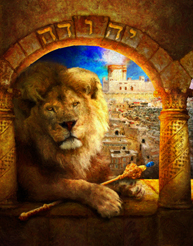 Judah / Yehudah / Y’hudah יְהוּדָה
Judah / Yehudah / Y’hudah יְהוּדָה
What imageries are included in the depiction of Judah?
s breastplate gem. The background shows the temple and the city of Jerusalem because the tribe inhabited Jerusalem during the reigns of king David and Solomon”
The Meaning of the Name Judah
Genesis 29:35 reads: “She (Leah) conceived again, and when she gave birth to a son she said, “This time I will praise the L-rd.” So she named him Judah;” therefore; Judah means worshipper/praiser of the Lord.
The Biblical Blessings for the Tribe
Jacob’s blessing for the tribe of Judah is found in Gen. 49:8-12, “Judah, your brothers will praise you; your hand will be on the neck of your enemies; your father’s sons will bow down to you. You are a lion’s cub, O Judah; you return from the prey, my son. Like a lion he crouches and lies down, like a lioness—who dares to rouse him? The scepter will not depart from Judah, nor the ruler’s staff from between his feet, until he comes to whom it belongs and the obedience of the nations is his. He will tether his donkey to a vine, his colt to the choicest branch; he will wash his garments in wine, his robes in the blood of grapes. His eyes will be darker than wine, his teeth whiter than milk.”
Moses blessed the tribe by saying: “Hear, O L-rd, the cry of Judah; bring him to his people. With his own hands he defends his cause. Oh, be his help against his foes!” Deut. 33:7
Tribal Symbols
A Lion is sometimes exchanged for a crown, or a scepter. The Lion represents strength, authority and royalty. Jerusalem is also associated with Judah.
Tribal Territory
The tribe of Judah inhabited Jerusalem during the reign of king David and Solomon. At its height, the Tribe of Judah was the leading tribe of the Kingdom of Judah, and occupied most of the territory of the kingdom. The size of the territory of the tribe of Judah meant that in practice it had four distinct regions: the Negevthe southern portion of the land, which was highly suitable for pasture; the lowland (Shephelahcoastal region, between the highlands and the Mediterranean sea, which was used for agriculture, in particular for grainsthe barren region immediately next to the Dead Sea, and below sea level, which was wild, and barely inhabitable. This included the wilderness of En Gedi, the wilderness of Judah and the wilderness of Maonthe elevated plateau situated between the Shephelah and the wilderness, with rocky slopes, but very fertile soil. This region was used for the production of grain, olives, grapes, and other fruit; and hence, produced oil and wine.
Additional Notes
Judah was the fourth-born. An interesting fact is that the number four corresponds to the letter dalet. Judah (Yehudah) is spelled: Yod Hey Vav Dalet Hey. Without the dalet his name would be the name of G-d—the Yod Hey Vav Hey in the Tetragrammaton.
The tribe of Judah gained the right to national leadership and royalty. They are the ancestor of Messiah. Many other central leaders as well as important literary prophets were also from this tribe including Isaiah, Amos, Habakkuk, Joel, Micah, Obadiah, Zechariah and Zephaniah. Yeshua was from the Davidic line, and was therefore ethnically a member of the tribe of Judah.
Judah’s Breastplate gem was a Nofech—a bluish-green carbuncle. This gemstone is said to have an efficacy in achieving victory over one’s enemies, internal and external. This is a primary attribute of the Kingdom, as well as the Baal Tsuvah, the Repenter, both of which are associated with Yehudah.
Judah’s color was sky-blue. Judah’s encampment in the wilderness was East of the Mishkan. From the East comes light for the world, therefore Judah, who represents sovereignty… dwelt east. They were the leaders of the journey. The sun rises in that direction. It is also the source of the East Wind, which is the most harmful of all the winds. The sky is created in such a manner so that there is a graduation from light to dark, simulating the rising of the sun from the East.